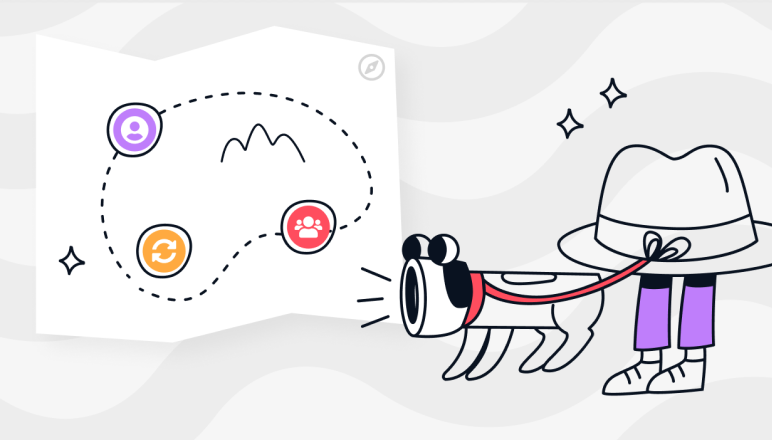Mastering Event Tracking in Google Analytics: Measuring and Analyzing User Interactions and Behaviors
Learn how to effectively track and analyze user interactions and behaviors in Google Analytics.
In today's digital age, understanding how users interact with your website is essential for success. This is where event tracking in Google Analytics comes into play. By accurately measuring and analyzing user interactions and behaviors, you can gain valuable insights that can help you optimize your website and improve user experience.
Understanding the Basics of Google Analytics
Before we dive into event tracking, let's start by understanding the fundamentals of Google Analytics. Simply put, Google Analytics is a powerful web analytics tool that provides you with insightful data about your website's performance. It allows you to track various metrics, such as page views, bounce rates, and conversions, to name just a few.
Google Analytics offers a comprehensive range of features that can help you gain a deeper understanding of your website's performance. From real-time data tracking to audience demographics and behavior analysis, Google Analytics equips you with the tools to make informed decisions and optimize your online presence effectively.
What is Google Analytics?
Google Analytics is a free tool provided by Google that helps you analyze your website's traffic and user behavior. It enables you to track and measure various aspects of your website's performance, allowing you to make data-driven decisions. With Google Analytics, you can gain deep insights into your audience, identify opportunities for improvement, and measure the success of your marketing efforts.
By utilizing Google Analytics, you can delve into detailed reports that showcase key performance indicators, user flow analysis, and conversion tracking. This wealth of data empowers you to tailor your website content and marketing strategies to better resonate with your target audience, ultimately driving higher engagement and conversions.
Importance of Event Tracking in Google Analytics
While Google Analytics provides an array of valuable data, event tracking takes it a step further by allowing you to measure specific user interactions on your website. These interactions can include button clicks, form submissions, video plays, file downloads, and much more.
Event tracking is especially crucial when you have specific goals in mind, such as increasing conversions or improving user engagement. By tracking these interactions, you can identify patterns, understand user behavior, and make informed decisions to optimize your website accordingly.
Furthermore, event tracking in Google Analytics enables you to set up custom events tailored to your unique business objectives. Whether you want to track newsletter sign-ups, social media shares, or product views, event tracking provides the flexibility to monitor and analyze the actions that matter most to your website's success.
Setting Up Event Tracking in Google Analytics
Now that you grasp the significance of event tracking, let's explore how to set it up in Google Analytics. Follow these steps to configure event tracking on your website:
Event tracking in Google Analytics is a powerful tool that allows you to track specific user interactions on your website. By setting up event tracking, you can gain valuable insights into how users engage with your content, such as clicking on buttons, downloading files, or watching videos. This data can help you make informed decisions to optimize your website and improve user experience.
Steps to Configure Event Tracking
1. Install the Google Analytics tracking code on your website.2. Identify the specific user interactions you want to track.3. Define goals and create corresponding events in Google Analytics.4. Implement event tracking code on your website's elements.5. Test and verify that the event tracking is working correctly.
Setting up event tracking requires careful planning and execution to ensure accurate data collection. By following these steps diligently, you can effectively track and measure user interactions on your website, leading to actionable insights for your business.
Common Mistakes to Avoid While Setting Up
While setting up event tracking, it's important to be aware of common mistakes that can hinder your data accuracy. These include:
- Incorrect implementation of event tracking code.
- Failing to set up meaningful events.
- Not properly testing event tracking functionality.
Avoiding these mistakes will ensure that your event tracking is accurate and provides reliable data for analysis.
Additionally, it's crucial to regularly review and refine your event tracking setup to adapt to changes in user behavior and website content. By continuously optimizing your event tracking strategy, you can stay ahead of the curve and make data-driven decisions to enhance your online presence.
Measuring User Interactions with Event Tracking
With event tracking in place, you can start measuring various user interactions on your website. Let's explore some examples of user interactions you can track:
First, let's talk about button clicks. By monitoring which buttons users are clicking the most, you can identify popular features or calls to action. This information can help you optimize your website's layout and design to enhance user experience and drive conversions.
Next, let's delve into form submissions. Tracking form submissions allows you to measure lead generation or sign-up conversion rates. By analyzing this data, you can identify any friction points in your forms and make necessary improvements to increase conversion rates.
Another important user interaction to track is video plays. Analyzing how users engage with your videos and whether they are watching them until the end can provide valuable insights. You can identify which videos are resonating with your audience and optimize your video content accordingly.
Lastly, let's discuss file downloads. By measuring the popularity of downloadable resources, you can understand which files are attracting the most interest. This information can help you tailor your content strategy and create more engaging resources that align with your audience's preferences.
Interpreting User Interaction Data
Once you have collected data on user interactions, it's essential to interpret and analyze it effectively. Google Analytics provides various reports and metrics to help you gain insights. Some key metrics to consider include:
- Event category: Categorize events based on their type, such as buttons, downloads, or videos. This categorization allows you to analyze user interactions within specific areas of your website.
- Event action: Measure the specific action associated with an event, such as button clicks or form submissions. Understanding the specific actions users take can help you identify patterns and optimize your website accordingly.
- Event label: Provide additional context by labeling events with specific information, such as button text or file name. This labeling allows for more detailed analysis and provides insights into user preferences.
- Total events: Understand the overall number of times an event has occurred. This metric helps you gauge the overall engagement level of your users and track the effectiveness of your website's interactive elements.
By analyzing these metrics and comparing them over time, you can uncover important trends, user preferences, and areas for improvement. This data-driven approach empowers you to make informed decisions and optimize your website to enhance user satisfaction and achieve your business goals.
Analyzing User Behaviors through Event Tracking
Now that we have covered the measurement of user interactions, let's explore how event tracking helps you analyze user behaviors on your website.
Understanding User Behavior Metrics
When it comes to analyzing user behaviors, Google Analytics offers a range of metrics that can provide valuable insights:
- Session duration: Measure how long users spend on your website and identify trends in session length.
- Pages per session: Understand how many pages users visit during a session to evaluate engagement levels.
- Bounce rate: Evaluate the percentage of users who leave your website after viewing only one page.
- Exit pages: Identify which pages users commonly exit your website from, indicating potential usability issues.
By combining user behavior metrics with event tracking data, you can gain a comprehensive understanding of how users navigate and engage with your website.
Strategies for Analyzing User Behavior Data
Effectively analyzing user behavior data can lead to actionable insights and opportunities for improvement. Here are some strategies to make the most of your analysis:
- Identify user behavior patterns: Look for recurring patterns in user interactions and behaviors to understand common user journeys.
- Segment your audience: Create audience segments based on specific behaviors or characteristics to tailor your marketing efforts effectively.
- Experiment and optimize: Leverage the insights from user behavior analysis to optimize your website and experiment with different strategies.
- Track the impact of changes: Continuously measure and analyze user behavior data to evaluate the impact of any optimizations or changes you make.
By following these strategies, you can improve the user experience on your website and enhance overall performance.
Optimizing Your Website Based on Event Tracking Insights
Event tracking provides valuable insights into user interactions and behaviors, but the true power lies in the ability to optimize your website based on these insights.
Making Data-Driven Decisions
Thanks to event tracking data, you can make informed decisions backed by real user behaviors. Instead of relying on guesswork or assumptions, you can rely on tangible data to drive your optimization efforts.
For example, if you track button clicks and discover that users rarely click on a particular button, you can consider redesigning the button's placement, size, or color to make it more enticing and increase engagement.
Continuous Improvement through Regular Analysis
Optimization is an ongoing process, and event tracking allows you to continuously monitor user interactions and behaviors. By regularly analyzing the data, you can identify trends, spot areas for improvement, and make iterative changes to optimize your website.
Remember to set benchmarks, track progress, and continuously refine your analysis techniques to stay ahead of the curve and provide the best user experience possible.
In conclusion, mastering event tracking in Google Analytics is a game-changer when it comes to measuring and analyzing user interactions and behaviors on your website. By setting it up properly, measuring user interactions, analyzing user behaviors, and optimizing based on valuable insights, you can enhance your website's performance and drive success in the digital landscape.
Ready to take your analytics to the next level? CastorDoc is here to elevate your business with AI-powered insights, offering a seamless, self-service analytics experience. Our platform not only enhances your data literacy but also ensures you make the most out of your data stack investment. With CastorDoc, you gain the autonomy to swiftly access and interpret data, enabling informed decisions that drive strategic success. Don't let complexity hold you back. Try CastorDoc today and unlock the full potential of your analytics.
You might also like
Get in Touch to Learn More



“[I like] The easy to use interface and the speed of finding the relevant assets that you're looking for in your database. I also really enjoy the score given to each table, [which] lets you prioritize the results of your queries by how often certain data is used.” - Michal P., Head of Data




.png)
%202.png)

%202.png)

%202.png)
%202.png)
%202.png)

%202.png)


%202.png)

%202.png)


.png)

